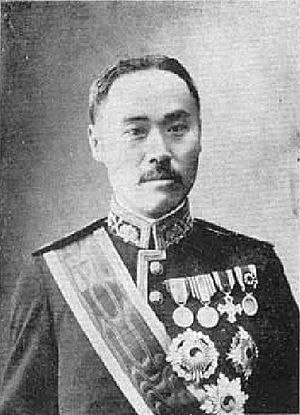Ye Wanyong facts for kids
Quick facts for kids
Ye Wanyong
|
|
|---|---|
|
이완용
|
|
 |
|
| 7th Prime Minister of Korea | |
| In office 11 August 1910 – 29 August 1910 |
|
| Monarch | Sunjong |
| Preceded by | Pak Che-soon |
| Succeeded by | Office abolished |
| Personal details | |
| Born | 17 July 1858 Seongnam, Korea (now Seongnam, South Korea) |
| Died | 12 February 1926 (aged 67) Keijō, Japanese Korea (now Seoul, South Korea) |
| Ye Wanyong | |
| Hunminjeongeum | |
|---|---|
| Hanja | |
| Revised Romanization | I Wanyong |
| McCune–Reischauer | Yi Wanyong |
| Art name | |
| Hunminjeongeum |
일당
|
| Hanja | |
| Revised Romanization | Ildang |
| McCune–Reischauer | Iltang |
| Courtesy name | |
| Hunminjeongeum |
경덕
|
| Hanja | |
| Revised Romanization | Gyeongdeok |
| McCune–Reischauer | Kyŏngdŏk |
Ye Wan-yong (17 July 1858 – 12 February 1926) was an important Korean politician. He is also known as Yi Wan-yong or Lee Wan-yong. He served as the 7th Prime Minister of Korea. Ye Wan-yong is mainly remembered for signing the Japan–Korea Annexation Treaty. This treaty put Korea under Japanese rule in 1910. He was seen as being friendly towards Japan.
Contents
Early Life and Education
Ye Wan-yong was born in 1858. His family was not rich, but he got a lot of support. This was because he became the adopted son of Ye Ho-jun. Ye Ho-jun was a friend of a powerful person called Heungseon Daewongun.
Ye Wan-yong learned English and studied at a special school called Yookyoung Park. He even lived in the United States for a while as a diplomat. When he came back to Korea, he first supported Russia. But as Japan became stronger, he started to support Japan instead.
In 1896, Ye was one of the people who started the Independence Club. This group wanted to make Korea more modern, like Western countries. They also wanted Korea to trade more with other countries.
Political Career and Treaties
Ye Wan-yong was a key government minister when the Eulsa Treaty was signed in 1905. He strongly supported this agreement. The treaty made the Korean Empire a protectorate of Japan. This meant Korea lost its power to deal with other countries on its own.
The Korean Emperor Gojong did not want to sign this treaty. Because Ye Wan-yong and four other ministers supported it, they were later called the "Five Eulsa Traitors" in Korea.
Becoming Prime Minister
From 1906 to 1910, Ye Wan-yong became the Prime Minister. This happened under the Japanese leader in Korea, Itō Hirobumi.
In 1907, Emperor Gojong tried to tell the world that the Eulsa Treaty was unfair. He did this at a meeting called the Hague Peace Conference. Ye Wan-yong played a big part in forcing Emperor Gojong to step down after this.
Later in 1907, Ye also supported another treaty, the Japan–Korea Treaty of 1907. This treaty gave Japan even more control over Korea's internal matters. This completed Japan's control over Korea. For this, Ye is also known as one of the "Seven Jeongmi Traitors" in Korea. In 1909, he was badly hurt in an attempt to kill him.
Under Japanese Rule
In 1910, Ye Wan-yong signed the Japan-Korea Annexation Treaty. This treaty meant Japan took full control of Korea. The Korean Emperor Sunjong refused to sign it.
Because Ye cooperated with the Japanese, he is also listed as one of the "Eight Gyeongsul Traitors" in Korea. Japan rewarded him by giving him a special noble title, a "Count," in 1910. This title was raised to "Marquis" in 1921. He passed away in 1926.
Legacy and Impact
Today, Ye Wan-yong's name is often used to mean "traitor" in South Korea.
However, a newspaper called Dongnip Sinmun (Independence Newspaper), run by Seo Jae-pil, never criticized him.
In 2005, South Korea passed a special law. This law allowed the government to take back property from the families of people who had helped Japan when Korea was taken over in 1910. Ye Wan-yong's family was one of those whose property was taken.
See also
 In Spanish: Ye Wanyong para niños
In Spanish: Ye Wanyong para niños


